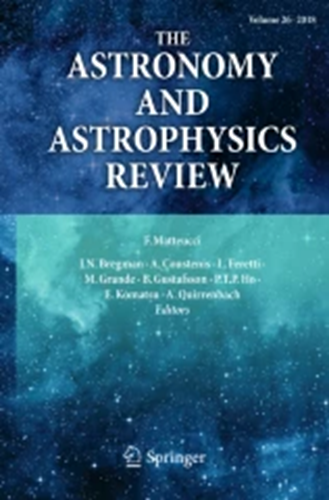Structured velocity field in the inner envelope of B335: ALMA observations of rare CO isotopologues
IF 27.8
1区 物理与天体物理
Q1 ASTRONOMY & ASTROPHYSICS
引用次数: 4
Abstract
Studying Class 0 objects is very important, as it allows to characterize dynamical processes at the onset of the star formation process, and to determine the physical mechanisms responsible for the outcome of the collapse. Observations of dense gas tracers allow the characterization of key kinematics of the gas directly involved in the star-formation process, such as infall, outflow or rotation. This work aims at investigating the molecular line velocity profiles of the Class 0 protostellar object B335 and attempts to put constraints on the infall motions happening in the circumstellar gas of the object.} Observations of C$^{17}$O (1-0), C$^{18}$O (1-0) and $^{12}CO$ (2-1) transitions are presented and the spectral profiles are analyzed at envelope radii between 100 and 860 au. C$^{17}$O emission presents a double peaked line profile distributed in a complex velocity field. Both peaks present an offset of 0.2 to 1 km s$^{-1}$ from the systemic velocity of the source in the probed area. The optical depth of the C$^{17}$O emission has been estimated and found to be less than 1, suggesting that the two velocity peaks trace two distinct velocity components of the gas in the inner envelope. After discarding possible motions that could produce the complex velocity pattern, such as rotation and outflow, it is concluded that infall is producing the velocity field. Because inside-out symmetric collapse cannot explain those observed profiles, it is suggested that those are produced by non-isotropic accretion from the envelope into the central source along the outflow cavity walls.B335包壳结构速度场:稀有CO同位素的ALMA观测
研究0级天体非常重要,因为它可以表征恒星形成过程开始时的动力学过程,并确定导致坍缩结果的物理机制。对致密气体示踪剂的观测,可以表征直接参与恒星形成过程的气体的关键运动学,如流入、流出或旋转。本工作旨在研究0级原恒星天体B335的分子线速度分布,并试图对该天体的星周气体中发生的落入运动施加约束。给出了C$^{17}$O(1-0)、C$^{18}$O(1-0)和$^{12}CO$(2-1)跃迁的观测结果,并分析了包络半径在100 ~ 860 au之间的光谱剖面。C$^{17}$O发射在复杂速度场中呈双峰线分布。这两个峰与探测区域内源的系统速度有0.2 ~ 1 km s$^{-1}$的偏移。C$^{17}$O发射的光学深度已被估计并发现小于1,这表明两个速度峰追踪了内包层中气体的两个不同的速度分量。在排除了可能产生复杂速度模式的运动,如旋转和流出后,得出了下降产生速度场的结论。由于由内而外对称塌缩不能解释这些观测到的轮廓,因此认为这些轮廓是由沿流出腔壁从包络层向中心源的非各向同性吸积产生的。
本文章由计算机程序翻译,如有差异,请以英文原文为准。
求助全文
约1分钟内获得全文
求助全文
来源期刊

The Astronomy and Astrophysics Review
地学天文-天文与天体物理
CiteScore
45.00
自引率
0.80%
发文量
7
期刊介绍:
The Astronomy and Astrophysics Review is a journal that covers all areas of astronomy and astrophysics. It includes subjects related to other fields such as laboratory or particle physics, cosmic ray physics, studies in the solar system, astrobiology, instrumentation, and computational and statistical methods with specific astronomical applications. The frequency of review articles depends on the level of activity in different areas. The journal focuses on publishing review articles that are scientifically rigorous and easily comprehensible. These articles serve as a valuable resource for scientists, students, researchers, and lecturers who want to explore new or unfamiliar fields. The journal is abstracted and indexed in various databases including the Astrophysics Data System (ADS), BFI List, CNKI, CNPIEC, Current Contents/Physical, Chemical and Earth Sciences, Dimensions, EBSCO Academic Search, EI Compendex, Japanese Science and Technology, and more.
 求助内容:
求助内容: 应助结果提醒方式:
应助结果提醒方式:


